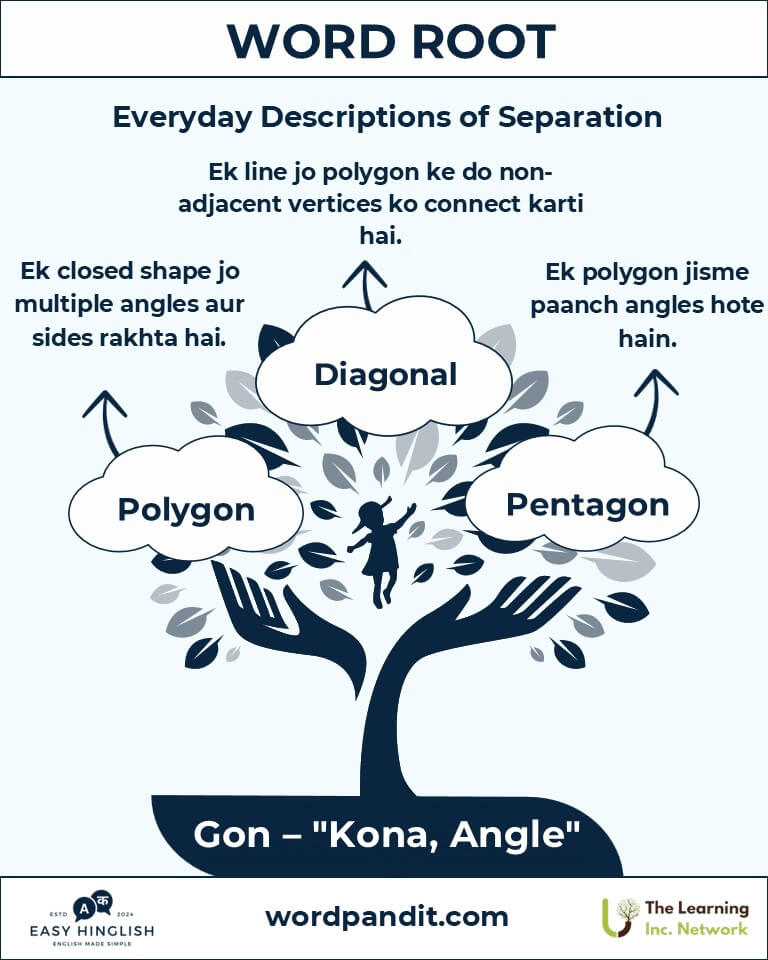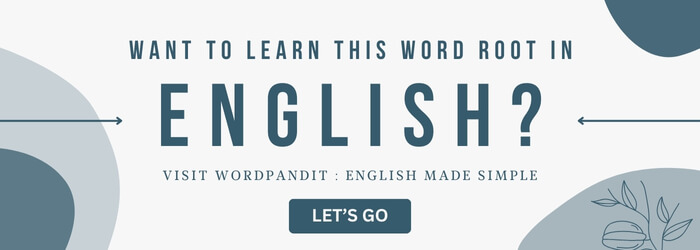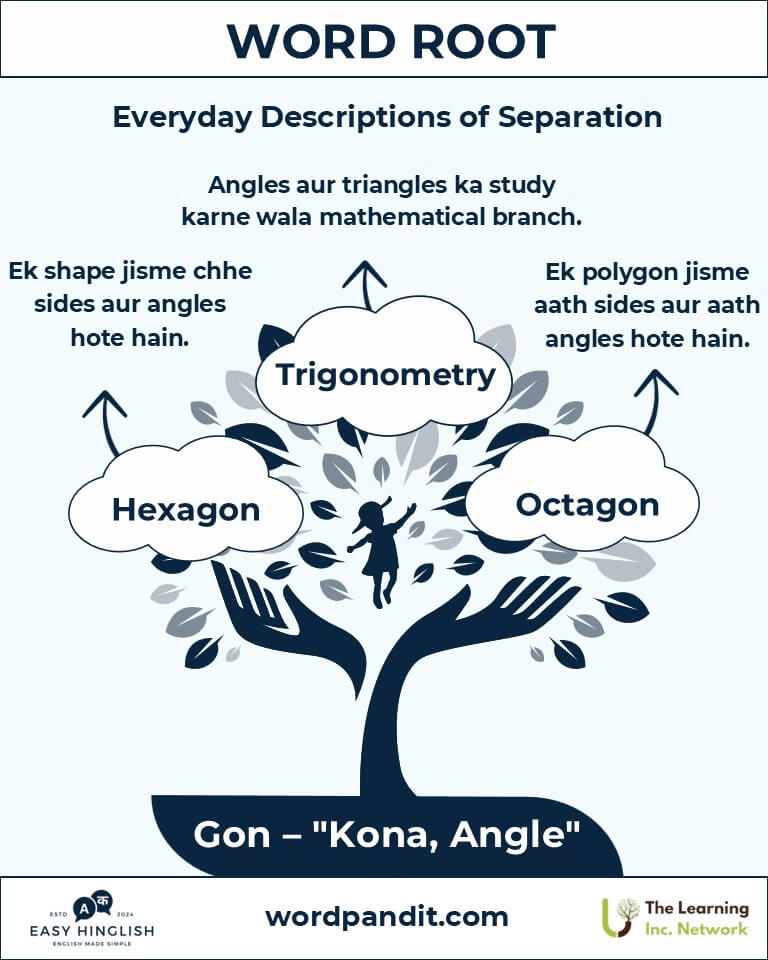Gon: The Root of Angles in Mathematics and Beyond
(Angles का मूल: Mathematics और Beyond के लिए "Gon")
Dive into the fascinating world of the root "gon," derived from the Greek word "gonia," meaning "angle" (कोण). This root forms the foundation of many geometric terms, such as polygons and diagonals, and highlights the importance of angles in mathematics, art, and daily life.

Table of Contents
- Introduction: The Essence of "Gon"
- Etymology and Historical Journey
- Mnemonic: Unlocking the Power of "Gon"
- Common "Gon"-Related Terms
- "Gon" Through Time
- "Gon" in Specialized Fields
- Illustrative Story: "Gon" in Action
- Cultural Significance of the "Gon" Root
- The "Gon" Family Tree
- FAQs About the "Gon" Root
- Test Your Knowledge: "Gon" Mastery Quiz
- Conclusion: The Enduring Legacy of "Gon"
Introduction: The Essence of "Gon"
(“Gon” का मूल अर्थ)
The root "gon" signifies angles and appears in numerous mathematical and geometric terms. Whether defining the shape of polygons or the direction of diagonals, "gon" plays a fundamental role in spatial understanding.

Etymology and Historical Journey
(शब्दों की उत्पत्ति और इतिहास)
The word "gon" comes from the Greek word "gonia," meaning "angle" or "corner." Over centuries, it became a key part of mathematical and architectural terminology, influencing modern geometry.
Mnemonic: Unlocking the Power of "Gon"
(Mnemonic के ज़रिए "Gon" को याद रखें)
Imagine a stop sign with multiple angles—it is an octagon! "Gon" helps define the structure of many geometric figures.
Mnemonic Device:
"Gon builds every shape we see, from triangles to polygons, infinitely!"
Common "Gon"-Related Terms
(“Gon” से जुड़े आम शब्द और उनके अर्थ)
- Polygon: A closed shape with multiple angles.
Example: "A hexagon has six angles and sides." - Diagonal: A straight line connecting non-adjacent vertices in a polygon.
Example: "The square's diagonal divides it into two triangles." - Trigonometry: The branch of mathematics that studies triangles and angles.
Example: "Trigonometry helps in navigation and engineering." - Pentagon: A five-sided polygon.
Example: "The Pentagon is a famous five-sided building." - Hexagon: A six-sided polygon.
Example: "Honeycombs have a natural hexagonal structure."
"Gon" Through Time
(समय के साथ "Gon" का सफर)
- Ancient Greece: "Gonia" was used in geometry and architecture.
- Middle Ages: "Gon" became essential in Islamic and European architecture.
- Modern Mathematics: "Gon" is central to trigonometry and geometry.
"Gon" in Specialized Fields
(विशेष क्षेत्रों में "Gon" का महत्व)
- Mathematics: Used in geometry, trigonometry, and topology.
- Architecture: Shapes like octagons and pentagons are used in design.
- Engineering: Calculating angles is critical in construction.
Illustrative Story: "Gon" in Action
(“Gon” की एक कहानी)
Arjun, an aspiring architect, was fascinated by geometric shapes. One day, he was tasked with designing a building inspired by nature. He observed honeycombs and realized that hexagons (six-sided polygons) provided maximum space efficiency. By applying his understanding of "gon," he created a revolutionary structure that was both strong and beautiful.
Cultural Significance of the "Gon" Root
(“Gon” Root का सांस्कृतिक महत्व)
Shapes like pentagons, hexagons, and octagons have been used in architecture for centuries. Ancient Greek temples, Islamic mosaics, and modern skyscrapers all rely on the mathematical precision of angles. Even in art and design, "gon" remains a foundation of creativity.

The "Gon" Family Tree
(“Gon” Family के संबंधित शब्द)
- Trigono- (Greek: "three angles")
- Trigonometry: The study of triangles and their properties.
- Trigon: An old term for a three-sided figure.
- Penta- (Greek: "five")
- Pentagon: A five-sided polygon.
- Hexa- (Greek: "six")
- Hexagon: A six-sided polygon.

FAQs About Glyc
Q: "Glyc" ka kya matlab hai aur yeh kahaan se aaya hai?
A: Glyc ka matlab hai "sweet" (मीठा), aur yeh Greek word "glukus" se aaya hai. Yeh root sugars aur energy-related scientific terms mein use hota hai.
Q: Glycerin kya hai aur yeh kyon zaruri hai?
A: Glycerin ek sweet aur colorless liquid hai jo cosmetics, medicine aur food products mein use hota hai. Yeh ek humectant ke roop mein moisture retain karta hai aur skin hydration mein madad karta hai.
Q: Body mein glycogen ka kya role hai?
A: Glycogen body ka primary glucose storage form hai jo liver aur muscles mein store hota hai. Energy ki zarurat padne par yeh glucose mein breakdown hota hai.
Q: Glycemic index se health kaise manage ki ja sakti hai?
A: Glycemic index carbohydrates ke blood sugar par effect ko measure karta hai. Low glycemic foods steady energy dete hain aur diabetes manage karne mein madad karte hain.
Q: Glycosides kya hote hain aur inka significance kya hai?
A: Glycosides sugar aur molecule ke chemical bonds hote hain jo plants mein milte hain. Yeh medicines mein use hote hain jaise heart conditions ke liye digitalis glycosides.
Test Your Knowledge: Glyc Mastery Quiz
1. Glyc ka kya matlab hai?
2. Muscles mein stored sugar kaunse term se refer kiya jaata hai?
3. Blood sugar response ko measure karne ke liye kaunsa term use hota hai?
4. Cosmetics mein ek sweet liquid kaunse term se refer hota hai?
5. Ek glycoside kya combine karta hai?
Conclusion: The Enduring Legacy of "Gon" ("Gon" का अमर महत्व)
"Gon" forms the cornerstone of geometric exploration, from the symmetry of polygons to the elegance of diagonals...








